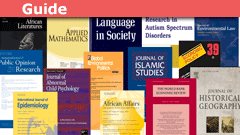Guide to Publishing in Peer Reviewed Journals
Table of Contents
From Concept to Manuscript
You’ve done the science. You had an idea, performed an extensive literature review, designed an experiment, ran the experiment, mucked the experiment up, repeated the cycle until you generated meaningful results, conducted a rigorous analysis and now, finally, you’ve written up your results complete with fancy graphs. You want to share your results with the academic world so your work can go down in history. So now what?
The publication process is critical to the process of science itself and to a scientist’s career. For better or worse, scientists are often judged on their publication output and the various indices associated with their quality (e.g. number of citations, h-index, g-index, i10-index ). And yet it’s rare for academic writing to be taught formally. In most cases, students are left to learn about the publication process through trial and error and the occasional input from a supervisor. As a result, the entire process can be incredibly mysterious and often agonizingly stressful. Hopefully, a little insight can help.
I have acted as a reviewer for journals including Medical Physics, Physics in Medicine and Biology, and the Journal of Applied Clinical Medical Physics, for almost a decade now. I’ve also had the opportunity to sit through a couple of workshops on academic publishing in my field. In what follows, I’ll try to give an overview of the publishing process from my point of view, along with some helpful tips on how to smooth out the bumps.
DISCLAIMER 1
Your mileage may vary. The publishing process does have idiosyncrasies that are field-specific. Experimental particle physicists for example publish through large collaborations that have rigorous internal reviews prior to journal submission.
DISCLAIMER 2
This article is written for a target audience of senior undergraduates or new graduate students in the physical sciences who are new to the publishing process, or for people who have published in the past and want to be more successful at it. It is in NO WAY intended as a substitute for formal academic training.
Manuscript Submission
Which Journal To Submit To?
One of the most common reasons for rejection is that the work is not appropriate for the particular journal. If you’re just starting out in your field this is where a supervisor/mentor or more experienced co-author can help. On your own, you should be able to narrow it down to a shortlist that consists of the journals you read on a regular basis or the ones that most frequently come up on your scholar alerts. Big hint: if you don’t read a given journal often, you should not be submitting to it. From there, consider which journal the majority of your citations come from and the journal’s target audience. You should also factor in the journal quality as well. Ideally, you want to maximize not necessarily the number of readers, but the overall impact of your work. Therefore you want to maximize readers who will have an interest in the work or are likely to find it useful. There’s not much point in selling hamburgers at a vegan convention.
I won’t wade into the debate about open-access journals here. But be aware that open-access (making the article freely available to readers for a fee that the author pays) is a growing trend and there are some journals on the market that will publish just about anything because they derive their income from the authors. Jeffrey Beall maintains a list of potentially predatory journals and publishers here. He also has a helpful guide for determining whether a publisher is predatory. Some big flags: (a) a journal editor you’ve never heard of emails you requesting that you submit an article, (b) no one in your peer group has ever read or heard of the journal, (c) the title seems like a knock-off of a more familiar journal, or (d) something about the journal’s contact information or its operations seems sketchy.
Preparing the Manuscript
Read and follow the journal’s guidelines. Try to follow the formatting specifications as closely as you can. Each journal will have specific rules about word count, citation style, figure format, etc. It may even be wise to seek out a template to start with. Papers are generally not rejected for formatting issues, but if an online submission system can’t turn your figures into a merged PDF, or your references become unreadable, it could result in delays and it makes everyone’s job more difficult.
Make as much of an effort as you can to be clear and concise in your writing. While it might be nice to think that a paper will stand or fall based only on its scientific merit, the quality of the writing and presentation can make the difference between acceptance and rejection. In fact, outside of scientific objections, poor writing is one of the most frequently cited reasons for rejection. Scientific writing is rarely taught with much emphasis to science students, which is unfortunate because the ability to communicate well is fundamental to their success.
One of the toughest issues to tackle for academic writers is that they are usually so involved in a problem, that it’s difficult to know what the reader does not know. We think in jargon. And sometimes what is blatantly obvious to us is not so obvious to the reader, even one in the field. So what can you do?
- Give yourself time to write. Start early and return to drafts of the manuscript as the project progresses. Writing time is constructive research time, not an add-on chore that you have to do after you’ve completed the “real” work.
- Follow an organized, logical format. It’s tempting to put in all the little details that went into the project because often the details have amounted to days of your time. But you have to be ruthless when organizing your information.
- As much as possible define terms and acronyms and avoid jargon. The more accessible your work is, the more likely it is to be cited.
- If it’s not blatantly obvious at this point: proofread. Nothing should leave your hard drive (or wherever you store your files) as a first draft.
(The irony of any mistakes in this article is not lost on me. No one is perfect.) - Solicit feedback. Look to your supervisor, other authors on the paper, supervisory committee, and peers. Even peers outside of your sub-field should be able to read and understand the basic concepts in your paper. And sometimes the opinion of someone outside of the problem can be very valuable.
- Engage with your audience. If you present the work at a conference, ask what people got out of your presentation or poster.
- Freely give feedback to others. Not only does this pay them back, but reading how other people write can help to improve your own writing.
- Take advantage of writing workshops, short courses, seminars, and opportunities for critical, constructive feedback on your writing. This is especially important if you are learning to write outside your first language.
- Sometimes professional editing services are an option, and you can consider them particularly if you get a review back that indicates you are struggling with communication issues.
Authorship
The general rule of thumb on who should be included as an author is that the person must have had a significant role in most aspects of the work including experimental design, execution, analysis, and manuscript preparation. A hallway discussion about your methods, or sharing some data from another work does not entitle someone to authorship. Nor does providing lab space or equipment or simply being a supervisor. (You have to be careful with this last point though. While you may have moral authority not to include someone, you don’t want to make a career-limiting move by excluding someone.) Journals will often publish a guideline for authorship, so when in doubt, it’s best to go to the source.
Another big point about authorship is that if your name goes on the paper, you are assuming responsibility for it. In an environment where publication quantity can have a direct effect on one’s career, people too often overlook this. If you’re a student and you get your name on a paper, it’s fair game for someone to approach you at a conference and discuss anything that’s in that paper.
The Peer Review Process
The process generally works as follows:
- The paper is submitted to a journal. It goes through a basic quality control review and goes to the editor or a designate. Note that it gets a timestamp here that will be published along with the article if it is eventually published.
- The editor chooses an associate editor (AE) who specializes in the paper’s general topic area. For smaller journals, the editor and AE may be the same person.
- The AE reads the manuscript and then chooses referees (commonly two) to review the paper. The AE must contact each reviewer and get each to agree to conduct the review. Referees are not reimbursed for their time. Sometimes a request to review can go unanswered for weeks. Normally it’s at least a few days. And sometimes the response is a no, which means the AE has to then go out and find someone else to solicit. While referees have a moral obligation to conduct reviews (someone has, after all, reviewed manuscripts that the referees have submitted), they are under no obligation to accept a particular paper.
In most cases, the process is at least blind from the author’s point of view. You won’t ever know who reviewed your paper. Sometimes double-blinding is done where the referees are not told who wrote the paper. Additionally, the referees are supposed to be free from any conflicts of interest. They should not have worked with the authors, should not have any commercial interests in the outcome of the review, and should be in a position to provide an unbiased review. - The referee reviews the paper. Usually, they have 2-3 weeks to do this. However, because it’s volunteer work, the AE has no authority to force the referee to conform to that time constraint. At best, if a reviewer is taking too long, the AE can find someone else. This is why some reviews can take months to get back. Reviews normally consist of: (i) a general summary of the paper, (ii) general comments that outline any major issues, (iii) a series of specific comments that can go line-by-line through the paper, and (iv) a recommendation to the editor of whether to accept, reject or require revision. That said, reviewers can really write anything they want. Some reviews can get as long as the manuscript itself. Other can be only a few sentences.
- The reviews are sent back to the AE. The AE then weighs each report and sometimes will weigh in with comments him or herself. Sometimes if there is a disagreement between the referees, a third referee will be added as a tie-breaker. The AE then makes a final recommendation to the editor. The editor is the person with the final say and this is who ultimately accepts or rejects the paper (not the referees). Almost always some revision will be required. I once heard a past editor of Medical Physics comment that over a decade he had seen only one paper ever come back without any recommended revisions. That’s about 1/10000. Expect revisions, even for a very good paper.
- The author hears back and is expected to respond to each of the points raised by the reviewers. Sometimes these are line corrections. Sometimes an experiment has to be repeated. It’s up to the author how to respond. Authors are permitted to disagree with referees, although they usually have to make a strong case when they do this. Once the points are addressed, the manuscript is revised and re-submitted.
- The cycle of review and response repeats. It’s rare to go through the cycle more than two or three times. If reviewers are not happy to accept the article after a third response, it’s unlikely they will ever be satisfied.
- On acceptance, the paper will go to a copy editor who will format it, make sure the citations are correct, correct spelling, and (sometimes) grammar. This person is generally not a scientist though. The copy editor sends a copy to the authors who have to go through all the minor formatting questions. Small revisions can be made at this point, but nothing that would affect the nature of the article.
It’s easy to see if you add up the time why it can take several months to go from initial submission to final publication. Do not expect a fast turnaround. It’s also easy to see that if you target an appropriate journal, follow the formatting guidelines, and make an effort to make your paper something that’s easy to read, you’ll get a faster response.
What Reviewers Look For
Reviewers are volunteers. They have been selected by the AE because they are experts in the field. This usually means they have published similar work. But they can be from varied backgrounds, and not all of them will understand what’s appropriate and inappropriate to comment on. They are human and will be subject to biases, will hold opinions, and can make mistakes. (The AE will usually step in if they go way out of bounds, but there can be a lot of grey areas). That said, the process is mitigated by the fact that roughly three people need to come to a consensus on a decision. So what do they look for?
- Is the paper appropriate for the audience?
First and foremost the referees are readers of the journal. Just because a paper is a good piece of work, doesn’t mean that it will be accepted. The topic and result have to contribute information that has significant value for the journal’s target community. (This brings back the point of appropriate journal selection saving everyone a lot of headaches.) - Is the work novel?
This means that the work has to contribute original and new information to the field. It is completely valid (and necessary) to independently confirm another group’s results, particularly if those results are controversial, or have some uncertainty associated with them. So novel does not necessarily mean “the first time something has been observed or achieved.” Rejections for lack of novelty come if the results only confirm something that is already well-established in the field. - Is the work significant?
The article needs to be more than an incremental addition or trivial extension of existing work. I won’t pretend there isn’t some gray area here and it’s very difficult to define “significant.” Being well-read in your field will help you to recognize (and articulate) the difference between a trivial step and a significant contribution to the field. If you can imagine one of the big names in your field sitting down and reading your paper, it would be significant if that person’s overall understanding of the field is improved. - Is the science correct?
This is the meat of peer review. I won’t attempt a sermon on what constitutes “correct” or “good” science. But expect reviewers to go through your work with a fine-tooth comb. They won’t repeat everything you’ve done, but they will generally spot inconsistencies with convention. They will look for holes in your process, and challenge any conclusions drawn from your data. To borrow from politics, you might consider the reviewers as the scientific loyal opposition. It’s their job to find problems with the paper. Expect to be challenged. - Is the discussion relevant?
As the reviewers read questions will come up: Did the authors consider other conditions? How are these results relevant to the bigger picture? In what context should one interpret the results? Predicting these is an art form in and of itself. Expect reviewers to comment on discussion points, suggest the addition of new ones and the deletion of old ones. And remember, it’s easy to get off-topic. - The other stuff.
Reviewers will look at your references to see that the work is framed in the context of relevant literature and that all points made are backed up. (They likely won’t read all of your references, but are likely to be familiar with most of them.) They will look for logical consistency as well. Do the results plotted in figure 3 agree with those in figure 7? Do the parameters listed in your tables agree with those in your methods. (These are the kinds of little things that can easily thought cracks between draft revisions.)
Reviewers are not supposed to comment on the authors’ style. They’re not supposed to suggest different ways of approaching the problem or suggest new directions for research. But they will. They will give subjective opinions and sometimes even make suggestions that will degrade the quality of the manuscript.
Responding to Criticism
It can feel horrible to have your work torn apart. But criticism is part of the process and in the end, it will make your work stronger. Submission is not the end of a project – it’s the middle.
Things that can help you to deliver a strong response:
- Take time to digest the reviews. Read them thoroughly and then go and do something else. Try to understand the big picture.
- Address the major points first. There’s no point in correcting spelling errors in a paragraph that’s going to be deleted.
- Come up with a plan for addressing each point and meet with your co-authors to discuss it.
- Identify changes that are necessary and those that are optional.
- You don’t have to agree with every point a reviewer makes. But you do have to respond to every point.
- Prepare a thorough and articulate response that addresses each concern on a point-by-point basis. Put the same effort into this as you have with your primary submission.
- Track changes – at least for yourself. Some journals now require changes to be highlighted or tracked.
The Imperfect Process
Peer review is not a perfect process. It’s just as flawed as the collection of people involved in it. Reviewers will make mistakes. Articles that really shouldn’t be published will get through. Other stuff that is brilliant and well-written will be harshly criticized and rejected. But it’s one of the foundational components of modern science because it enables anyone’s work to be freely criticized without fear of repercussion.
“Choppy” works as a senior medical physicist in Alberta, Canada. He received a PhD in medical physics from the University of Alberta in 2005. He has been a Member of the Canadian College of Physicists in Medicine since 2009 and a Fellow since 2014. He is also an Adjunct Assistant Professor at the University of Calgary in both the Department of Oncology and the Department of Physics and Astronomy.





What I’ve been looking and waiting for. THANKS!
This accords with my experience.
Great job, Choppy.
Excellent writeup! I'm going to be a junior in the fall, so I'm a ways away from having to worry about this. However, there was some very valuable information here. I've wondered about the paper submission process in general, and this laid it out very clearly. Thanks!
Great guide!
Another smash hit guide from @choppy!
Article like this is a must-read for every young scientist who just "hatched" from the class-based education period and start doing on his own for his research, it worths the time reading.